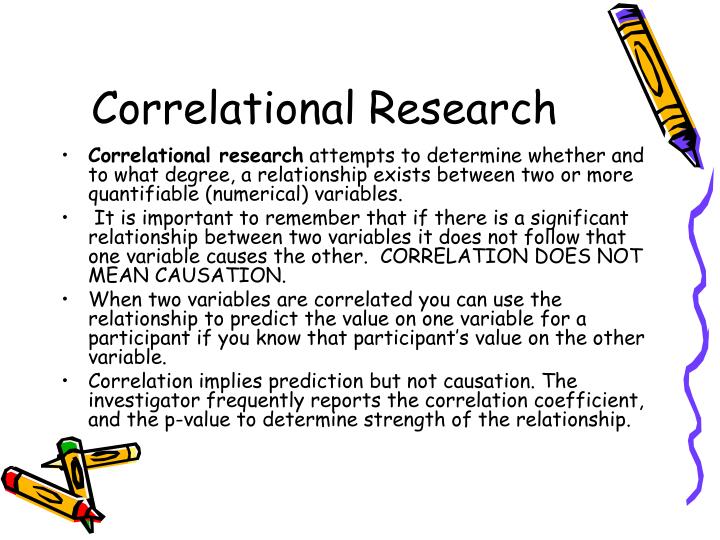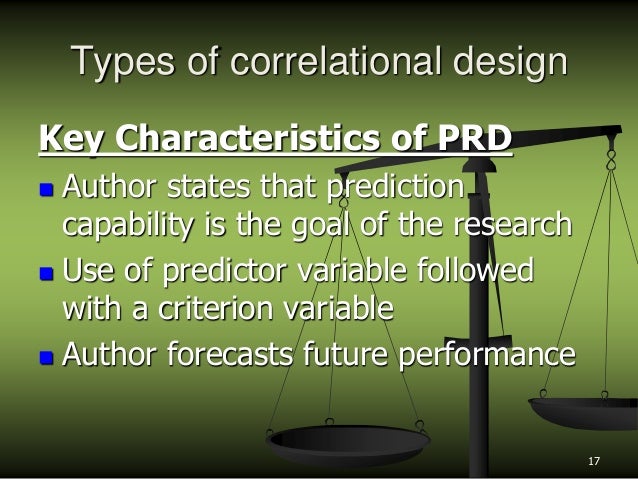Table Of Content
- Research on a New Soundscape Evaluation Method Suitable for Scenic Areas
- Research Methods in Psychology – 2nd Canadian Edition
- Correlational Research Guide, Design & Examples
- Does Correlational Research Always Involve Quantitative Variables?
- What are the Data Collection Methods in Correlational research?

Figure 6.2 shows data from a hypothetical study on the relationship between whether people make a daily list of things to do (a “to-do list”) and stress. Notice that it is unclear whether this is an experiment or a correlational study because it is unclear whether the independent variable was manipulated. If the researcher randomly assigned some participants to make daily to-do lists and others not to, then it is an experiment. If the researcher simply asked participants whether they made daily to-do lists, then it is a correlational study. The distinction is important because if the study was an experiment, then it could be concluded that making the daily to-do lists reduced participants’ stress. But if it was a correlational study, it could only be concluded that these variables are statistically related.
Research on a New Soundscape Evaluation Method Suitable for Scenic Areas
Correlational studies are non-experimental, which means that the experimenter does not manipulate or control any of the variables. Different types of correlation coefficients might be appropriate for your data based on their levels of measurement and distributions. The Pearson product-moment correlation coefficient (Pearson’s r) is commonly used to assess a linear relationship between two quantitative variables. Use the correlational research method to conduct a correlational study and measure the statistical relationship between two variables. Use QuestionPro’s research platform to uncover complex insights that can propel your business to the forefront of your industry. The correlation coefficient shows the correlation between two variables (A correlation coefficient is a statistical measure that calculates the strength of the relationship between two variables), a value measured between -1 and +1.
Research Methods in Psychology – 2nd Canadian Edition
Correlational studies are often used in psychology, as well as other fields like medicine. Correlational research is a preliminary way to gather information about a topic. Surveys are a quick, flexible way to collect standardised data from many participants, but it’s important to ensure that your questions are worded in an unbiased way and capture relevant insights. Correlational research can provide initial indications or additional support for theories about causal relationships. You want to find out if there is an association between two variables, but you don’t expect to find a causal relationship between them. Such considerations must be incorporated in all types of correlational research design.
Correlational Research Guide, Design & Examples
(There are also statistical methods to correct Pearson’s r for restriction of range, but they are beyond the scope of this book). Another strength of correlational research is that it is often higher in external validity than experimental research. Recall there is typically a trade-off between internal validity and external validity. As greater controls are added to experiments, internal validity is increased but often at the expense of external validity as artificial conditions are introduced that do not exist in reality. In contrast, correlational studies typically have low internal validity because nothing is manipulated or controlled but they often have high external validity.
A scatterplot is a graphical representation of the relationship between two variables. The x-axis represents one variable, and the y-axis represents the other variable. The pattern of data points on the plot can provide insights into the strength and direction of the relationship between the two variables.

You can observe people and gather information from them in various public places such as stores, malls, parks, playgrounds, etc. It helps find the association between variables based on the participants’ responses selected for the study. In correlational research design, a researcher measures the association between two or more variables or sets of scores. The distinctive feature of correlational research is that the researcher can’t manipulate either of the variables involved. A researcher could observe participants in a closed environment or a public setting.
Does Correlational Research Always Involve Quantitative Variables?
In fact, the terms independent variable and dependent variable do not apply to this kind of research. There are many reasons that researchers interested in statistical relationships between variables would choose to conduct a correlational study rather than an experiment. The first is that they do not believe that the statistical relationship is a causal one or are not interested in causal relationships.
What are the Data Collection Methods in Correlational research?
There are advantages and disadvantages to each of the three design options presented above. This is an example of content analysis—a family of systematic approaches to measurement using complex archival data. Just as naturalistic observation requires specifying the behaviors of interest and then noting them as they occur, content analysis requires specifying keywords, phrases, or ideas and then finding all occurrences of them in the data. They simply measured out a 60-foot distance along a city sidewalk and then used a stopwatch to time participants as they walked over that distance.
When to use correlational research
After creating your correlational research survey, you can share the personalized link with respondents via email or social media. This method is extremely demanding as the researcher must take extra care to ensure that the subjects do not suspect that they are being observed else they deviate from their natural behavior patterns. It is best for all subjects under observation to remain anonymous in order to avoid a breach of privacy. Sporadic change patterns that occur in variables with zero correlational are usually by chance and not as a result of corresponding or alternate mutual inclusiveness. A cross-sectional survey is a type of cross-sectional study where the data source is drawn from postal questionnaires and interviews.
Researchers Robert Levine and Ara Norenzayan used naturalistic observation to study differences in the “pace of life” across countries (Levine & Norenzayan, 1999). One of their measures involved observing pedestrians in a large city to see how long it took them to walk 60 feet. For example, people in the United States and Japan covered 60 feet in about 12 seconds on average, while people in Brazil and Romania took close to 17 seconds.
The strength of correlation refers to how closely the data points cluster around a straight line on the scatterplot. A correlation coefficient close to -1 or +1 indicates a strong relationship between the variables, while a coefficient close to 0 suggests a weak relationship. A correlation coefficient is an important value in correlational research that indicates whether the inter-relationship between 2 variables is positive, negative or non-existent. It is usually represented with the sign [r] and is part of a range of possible correlation coefficients from -1.0 to +1.0.
Spatial correlation between producer services agglomeration and carbon emissions in the Yangtze River Economic ... - Nature.com
Spatial correlation between producer services agglomeration and carbon emissions in the Yangtze River Economic ....
Posted: Wed, 05 Apr 2023 07:00:00 GMT [source]
Grocery shoppers putting items into their shopping carts, for example, are engaged in public behavior that is easily observable by store employees and other shoppers. While correlational research does not involve manipulating variables, researchers can use experimental design to establish cause-and-effect relationships between variables. Experimental design involves manipulating one variable while holding other variables constant to determine the effect on the dependent variable.
When you see one variable changing, you have a fair idea of how the other variable will change. Correlational research is also widely utilized in the business and management fields to explore relationships between organizational variables and outcomes. By examining correlations between different factors within an organization, researchers can identify patterns and trends that may impact performance, productivity, and profitability. One of the primary considerations in correlational research is the presence of third variables, also known as confounding variables.
That helps you generalise your findings to real-life situations in an externally valid way.
The target behaviours must be defined in such a way that different observers code them in the same way. This difficulty with coding is the issue of interrater reliability, as mentioned in Chapter 5. Researchers are expected to demonstrate the interrater reliability of their coding procedure by having multiple raters code the same behaviours independently and then showing that the different observers are in close agreement. They found that people in some countries walked reliably faster than people in other countries.

No comments:
Post a Comment